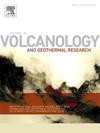Insights into caldera cycles obtained from the eruption ages and chemistry of the youngest products of Nisyros volcano, South Aegean Arc
IF 2.4
3区 地球科学
Q2 GEOSCIENCES, MULTIDISCIPLINARY
Journal of Volcanology and Geothermal Research
Pub Date : 2025-01-27
DOI:10.1016/j.jvolgeores.2025.108281
引用次数: 0
Abstract
Hazards posed by volcanism are strongly associated with the volcanoes' shifts in eruptive styles, as they often alternate between effusive and explosive activity with little to no forewarning. These shifts are thought to be governed by processes happening in conduits and reservoirs feeding magmas to the surface. In hope to forecast eruptive activity (including styles), it is critical to better understand these governing processes. Here, we consider the case study of Kos-Nisyros-Yali volcanic field (Aegean Arc), which has experienced several caldera-collapse events in the last few hundreds of thousands of years and undergone multiple shifts in eruptive style. We conduct bulk-rock geochemical analyses and U![]() Th disequilibrium dating of zircon on eight of the post-caldera domes, which form the youngest volcanic deposits on Nisyros, to better understand the most recent stage of activity at this volcano and its implications on future eruptions. Zircon U/Th ages indicate that the domes formed between ca. 26 ka and 13 ka, 30 ky after the volcano's most recent caldera-collapse eruption. We observe a spatial migration of vents as well as a slight shift to more mafic bulk-rock compositions with time, which could reflect a growing influence of persistent mafic recharge pulses into the upper-crustal magma chamber throughout the eruptive period. Based on the eruption timings, compositions of fumaroles, and recent observations during unrest on Nisyros, we suggest that the upper-crustal magma reservoir is currently in a water-saturated state, which favors its growth and infrequent effusive eruptions.
Th disequilibrium dating of zircon on eight of the post-caldera domes, which form the youngest volcanic deposits on Nisyros, to better understand the most recent stage of activity at this volcano and its implications on future eruptions. Zircon U/Th ages indicate that the domes formed between ca. 26 ka and 13 ka, 30 ky after the volcano's most recent caldera-collapse eruption. We observe a spatial migration of vents as well as a slight shift to more mafic bulk-rock compositions with time, which could reflect a growing influence of persistent mafic recharge pulses into the upper-crustal magma chamber throughout the eruptive period. Based on the eruption timings, compositions of fumaroles, and recent observations during unrest on Nisyros, we suggest that the upper-crustal magma reservoir is currently in a water-saturated state, which favors its growth and infrequent effusive eruptions.
从南爱琴海弧尼西罗斯火山喷发年龄和最年轻产物的化学成分中获得对火山口循环的见解
火山活动造成的危险与火山喷发方式的变化密切相关,因为它们经常在几乎没有预警的情况下在喷涌和爆发活动之间交替。这些变化被认为是由将岩浆输送到地表的管道和储层中发生的过程控制的。为了预测喷发活动(包括喷发风格),更好地理解这些控制过程是至关重要的。在这里,我们考虑了科斯-尼西罗斯-耶利火山场(爱琴海弧)的案例研究,该火山场在过去几十万年中经历了几次火山口崩塌事件,并经历了多次喷发风格的转变。我们对形成Nisyros上最年轻的火山沉积物的8个后破火山口圆顶进行了块状岩石地球化学分析和锆石UTh不平衡定年,以更好地了解该火山最近的活动阶段及其对未来喷发的影响。锆石U/Th年龄表明,这些圆顶形成于约26 ka至13 ka之间,即火山最近一次火山口崩塌喷发后30天。我们观察到喷口的空间迁移,以及随着时间的推移向更基性的块状岩石成分的轻微转变,这可能反映了在整个喷发期间,持续的基性补给脉冲对地壳上岩浆房的影响越来越大。根据喷发时间、喷气孔组成以及最近在Nisyros上的骚乱期间的观测,我们认为地壳上岩浆储层目前处于水饱和状态,这有利于其生长和不频繁的喷发。
本文章由计算机程序翻译,如有差异,请以英文原文为准。
求助全文
约1分钟内获得全文
求助全文
来源期刊
CiteScore
5.90
自引率
13.80%
发文量
183
审稿时长
19.7 weeks
期刊介绍:
An international research journal with focus on volcanic and geothermal processes and their impact on the environment and society.
Submission of papers covering the following aspects of volcanology and geothermal research are encouraged:
(1) Geological aspects of volcanic systems: volcano stratigraphy, structure and tectonic influence; eruptive history; evolution of volcanic landforms; eruption style and progress; dispersal patterns of lava and ash; analysis of real-time eruption observations.
(2) Geochemical and petrological aspects of volcanic rocks: magma genesis and evolution; crystallization; volatile compositions, solubility, and degassing; volcanic petrography and textural analysis.
(3) Hydrology, geochemistry and measurement of volcanic and hydrothermal fluids: volcanic gas emissions; fumaroles and springs; crater lakes; hydrothermal mineralization.
(4) Geophysical aspects of volcanic systems: physical properties of volcanic rocks and magmas; heat flow studies; volcano seismology, geodesy and remote sensing.
(5) Computational modeling and experimental simulation of magmatic and hydrothermal processes: eruption dynamics; magma transport and storage; plume dynamics and ash dispersal; lava flow dynamics; hydrothermal fluid flow; thermodynamics of aqueous fluids and melts.
(6) Volcano hazard and risk research: hazard zonation methodology, development of forecasting tools; assessment techniques for vulnerability and impact.

 求助内容:
求助内容: 应助结果提醒方式:
应助结果提醒方式:


